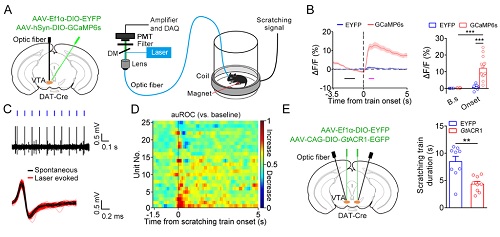Time:2018-09-29
A recent study published in Journal of Neuroscience demonstrated that dopaminergic neurons in the ventral tegmental area (VTA) play important roles in modulating itch signals. This work was performed by researchers in Dr. SUN Yan-gang’s Lab at the Institute of Neuroscience, Chinese Academy of Sciences. By combining fiber photometry, extracellular recording and optogenetic manipulation, this work showed that dopaminergic neurons in the VTA mainly exhibited elevated neural activity during itch-induced scratching, and that the neural activation was essential for the ongoing scratching.
Itch triggers a scratching response, leading to severe skin damage in patients with chronic itch. In order to treat the excessive scratching behavior during chronic itch, it is critical to understanding the underlying modulatory mechanism. Neuromodulatory system plays an important role in dynamically regulating itch processing. Previous studies showed that pharmacological manipulation of dopamine D1 or D2 receptors affected scratching behavior in rodents and primates. However, the precise dynamics and functional role of dopaminergic neurons in itch processing still remain elusive.
In order to examine the temporal activity of dopaminergic neurons in the VTA during scratching, SUN’s Lab recorded the activity of VTA dopaminergic neurons and animals’ scratching behavior simultaneously after itch chemical induction in freely-moving mice. By fiber photometry recording, researchers found that the dopaminergic neurons exhibited elevated neural activity after scratching onset. By extracellular recording, they found that the majority of dopaminergic neurons increased activity, while some neurons decreased activity after scratching onset. To further test whether the elevated neural activity of dopaminergic neurons was essential for maintaining scratching, they inhibited dopaminergic neurons in the VTA specifically after scratching onset, and found that the duration of scratching was significantly decreased. To further dissect dopaminergic circuits underlying itch signals modulation, they recorded the activity of dopaminergic fibers in the nucleus accumbens, and found that the activity of dopaminergic fibers in the lateral shell of nucleus accumbens recapitulated the activation of dopaminergic neurons in the VTA during scratching behavior, suggesting distinct dopaminergic circuit is involved in itch modulation.
In this project, SUN’s Lab revealed the dynamics of dopaminergic neurons in the VTA during itch processing and its necessity for maintaining scratching. This work advances our understanding of the brain mechanisms underlying itch information regulation and sheds new light on treatments for chronic itch.
This work entitled “Dynamics and functional role of dopaminergic neurons in the ventral tegmental area during itch processing” was published as an Early Release article in Journal of Neuroscience on September 29, 2018. It was carried out mainly by YUAN Lei, with help from LIANG Tongyu and DENG Juan, under the supervision of Dr. SUN Yan-gang at the Institute of Neuroscience, Chinese Academy of Sciences. This work was supported by the National Natural Science Foundation of China (31771158, 31371122) and the Strategic Priority Research Program of the Chinese Academy of Sciences (XDBS01000000).

Figure legend: (A) Schematic of virus injection, optic fiber implantation and fiber photometry recording. Labeled areas: ventral tegmental area (VTA). (B) Averaged fluorescence increased after chloroquine induced scratching for the GCaMP6s group but not EYFP group. The black bar and magenta bar indicates the baseline period (-2.2 to -1 s) and scratching train onset period (0.6-1.2 s), separately. (C) Example recording of spontaneous and laser-evoked spikes in the VTA. Blue ticks, laser pulses (473 nm, 5 ms). (D) Responses of light-identified dopaminergic neurons to scratching train (-1.5 to 5 s) as showed by the auROC. (E) Optogenetic inhibition of VTA dopaminergic neurons attenuated chloroquine-induced scratching behavior.
 附件下载:
附件下载: